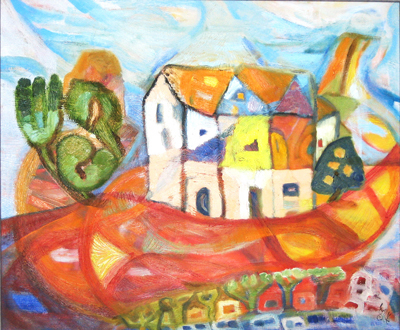
September Exhibition Keiko Yamano Exhibition Wednesday, September 6th --- Saturday, September 23rd, 2006 Reception: Friday, September 8th, 5:00-7:30PM News (Click Here!) Gallery Hour : Tuesday to Saturday 12:00 - 6:00PM |
 |
|---|
Meisui Hatano One Person Show Meisui Hatano's one-person show is an ambitious calligraphy exhibition with works the artist has applied her impressions and images of New Yorkers from her last visit to the city to the pictographic Chinese character "Šy" , pronounced raku, which expresses her creative imagination with the character as a motif. Without preconceived notions, the image created from the origin of the pictographic character, bells or percussion instrument for dance, is personified and arranged on the pictorial plane. The medium or process utilizes iro sumi, Japanese color ink, and staining with tanboku, diluted sumi ink. In addition, she works with sumi mixed with enamel which causes a repelling effect. Meisui was born and raised in Kasugai-shi, Aichi, the birth place of Ono no Doufuh (894-966) one of the three calligraphic masters of the Heian Period who established wafuh - Japanese style which differs from the Chinese. Meisei worked for an advertising firm before she became focused in studio work and now has a resume of group exhibitions and one-person shows. Her last show was at the Caelum Gallery in New York in January 2006. In this Gallery NYCoo show, her intension is to give herself a boost in her level of creativity by concentrating on a show here in Manhattan. Calligrapher Meisui's artistic territory encompasses, rinsho - based on working with classical samples of text , but mostly jiun - self interpretation. Her exploration extends from kanshi - Chinese poetry, and Chinese character combinations, modern poetry, English words, ancient Egyptian hieroglyphics, to finally cuneiform letters, one of the oldest writing systems. The Epic of Gilgamesh, the oldest written adventure legend was carved into clay slabs between 2750 to 2500 BC in Mesopotamia, Ancient Sumeria which is current day Iraq. The idea of using a calligraphy brush to express written expression that was done before the invention of the brush makes a strongly impression on our imaginations. It is said that sho - calligraphy reveals the person, then it can be said that painting reveals the person. This phrase can trigger the exploration for a personal understanding that can lead to a wide range of art appreciation. The Edo Period calligrapher Ryokan (1758 - 1931) known for his unconventional life style and calligraphy said that he strongly disliked the works of calligraphers. By this, one can presume that he is referring to the manneristic mediocrity that he observed in his time. This could be applied and restated as strong dislike for the works of professional painters. Ryokan in his time did not have the opportunity to see many good works of art as he did not live in a time that allows one to travel the world visiting museums. These thoughts come to mind in seeing this calligraphy show. Meisui says, "There is no theorizing needed. I just want people who see my work to be moved." The question arises here whether extending the territory encompassed by calligraphy means transcending the genre. The artist must be moved herself first before it can be transmitted to others. It is difficult to move the viewer in this day in age when the pioneering ideas of the early 20th century Dada Movement including the issue of transcending genre seems dated which is apparent at The Dada Show of this spring at the National Gallery in Washington, DC. Seeing a calligraphy exhibition in the English-speaking world brings about many thoughts and sensations. Your visit to the show is strongly recommende
|
| Gallery writer : Hitoshi Nakazato Translation : Sumiko Takeda |